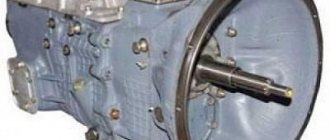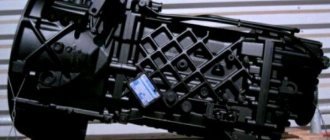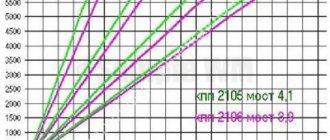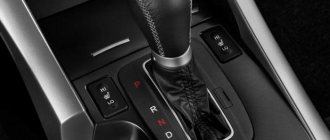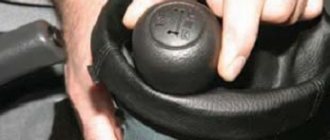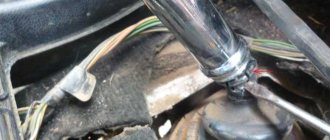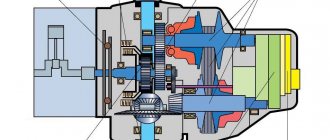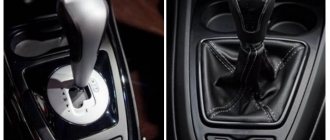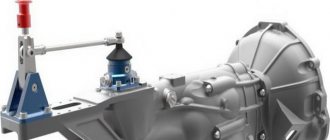Gearbox VAZ 2101 - PURPOSE
The gearbox (gearbox) of the VAZ 2101 is one of the main components of the car. The purpose of the mechanism is to convert the torque coming from the engine crankshaft and transmit it to the transmission.
DEVICE
The “penny” was equipped with a gearbox of four forward gears and one rear gear. Switching between stages is carried out by moving the gear shift knob located in the cabin. At the time of production, this type of gearbox was considered one of the best, which was due to minimal losses. The main elements of the box are the crankcase, the shift mechanism and three shafts:
- primary;
- secondary;
- intermediate.
Details of the gearbox input shaft: 1 - retaining ring;
2 - spring washer; 3 - bearing; 4 - input shaft; 5 — synchronizer spring; 6 — synchronizer blocking ring; 7 - retaining ring; 8 - bearing There are a lot of components in the box, but the unit has relatively small dimensions. To make it possible to disconnect the box from the engine, the connection is made through the clutch. The primary shaft of the unit has splines, through which it engages with the drive (driven disk). The primary shaft is mounted inside the box using bearing units: the front one is mounted in the rear part of the crankshaft, and the rear one is located in the box housing.
Details of the secondary shaft of the gearbox: 1 - retaining ring; 2 - spring washer; 3 — synchronizer hub; 4 — synchronizer clutch; 5 - retaining ring; 6 — synchronizer blocking ring; 7 — synchronizer spring; 8 — washer; 9 — gear III gear; 10 - secondary shaft; 11 - 2nd gear gear; 12 — washer; 13 — synchronizer spring; 14 — blocking ring; 15 — retaining ring; 16 — synchronizer hub; 17 — synchronizer clutch; 18 — retaining ring; 19 — synchronizer blocking ring; 20 — synchronizer spring; 21 — washer; 22 — 1st gear gear; 23 — bushing of the 1st gear gear; 24 - bearing; 25 — reverse gears; 26 — spring washer; 27 — retaining ring; 28 — speedometer drive gear; 29 — rear bearing; 30 — oil seal; 31 — elastic coupling flange; 32 - nut; 33 - seal; 34 - centering ring; 35 — retaining ring
The reverse end of the input shaft is equipped with a sprocket, which is a single piece with the shaft and is engaged with the intermediate shaft (inlet shaft). To prevent lubricant from leaking out of the box body, the rear bearing element is sealed with a cuff. The end part of the secondary shaft fits into the primary shaft.
The secondary shaft is centered using three bearings, which simultaneously ensure its fastening. A needle type is used at the front; it is located at the end of the input shaft. The second ball-type bearing is intermediate and is located behind the 1st gear gear. The third bearing is also a ball bearing and is located in the box housing cover behind the secondary shaft. The industrial shaft is located below the two previous shafts. At the same level with it there is a unit that allows the car to move backwards.
VAZ 2101 gearbox diagram: 1 - gearbox pan; 2 — plug for the hole for controlling the amount of gearbox lubricant; 3 — gear of the 2nd stage PrV; 4 — gear of the 3rd stage PrV; 5 — PrV with a set of gears; 6 — bearing PrV (front); 7 - thrust bolt; 8 — washer; 9 — PrV gear (with constant clutch); 10 — synchronizer washer for the 4th stage of the PV; 11 - input shaft; 12 — crankcase front cover; 13 — oil seal; 14 — bearing PV (rear); 15 — clutch housing; 16 — housing 17 — breather of the crankcase ventilation system; 18 — PV gear (with constant clutch); 19 — explosive bearing (front); 20 — 4th stage synchronizer ring; 21 — synchronizer clutch of the 3rd and 4th stages; 22 — 3rd stage synchronizer ring; 23 — 3rd stage synchronizer spring; 24 — gear of the 3rd stage of the explosive; 25 — gear of the 2nd stage of the explosive; 26 — hub of the synchronizer coupling of the 1st and 2nd stages; 27 - secondary shaft; 28 — gear of the 1st stage of the explosive; 29 — bushing; 30—BB bearing (intermediate); 31 — gear ZH BB; 32 — lever rod; 33 - pillow; 34 — bushing; 35,36 — bushings (remote, shut-off); 37 — boot (external); 38 — boot (internal); 39 — lever support washer (spherical); 40 — gearshift lever; 41 — explosive seal (rear); 42 — cardan coupling flange; 43 — nut BB; 44 - seal; 45 - ring; 46 — BB bearing (rear); 47 — odometer gear; 48 — odometer drive; 49 — gearbox housing cover (rear); 50 — fork ZX; 51 — gear ZX (intermediate); 52 — gear ZH PrV; 53 — axis of the intermediate gear ZX; 54 — gear of the 1st stage PrV; 55 - magnet; 56 - plug
SPECIFICATIONS
In order for the car to move at different speeds, each gear in the VAZ 2101 gearbox has its own gear ratios, which decrease as the gear increases:
- first - 3.753;
- second - 2.303;
- third - 1.493;
- fourth - 1.0;
- rear - 3.867.
Such combinations of gear ratios provide high traction in the first stage and maximum speed in the fourth. To reduce noise during operation of the unit, all gearbox gears operating while the machine moves forward are made with oblique teeth. Reverse gears have straight teeth. To ensure ease of control and gear changes with minimal loads (shocks), the forward stages are equipped with synchronizer rings.
WHAT TRANSMISSION TO PUT ON A VAZ 2101
The VAZ 2101 can be equipped with several options for boxes. Their choice depends on the goals being pursued, i.e. what the car owner wants to achieve: greater traction, dynamics, or whether a universal car is needed. The main difference between gearboxes is the difference in gear ratios.
FROM ANOTHER VAZ MODEL
Rear-wheel drive Zhigulis at the dawn of their production, in particular, the VAZ 2101/02, were equipped with only one gearbox - 2101 (they did not have a reversing light switch). A similar gearbox was installed on 21011, 21013, 2103. In 1976, a new unit 2106 with different gear ratios appeared. They were also equipped with the VAZ 2121. In 1979, another gearbox was introduced - 2105 with its own gear ratios, which were intermediate between 2101 and 2106. The 2105 gearbox could be used on any classic Zhiguli model.
On the VAZ 2101 you can install a five-speed gearbox 21074
Which box to choose for the VAZ 2101? It is worth taking into account that the most universal is the 2105 gearbox. When developing gearboxes, compromise parameters were selected between reliability, efficiency and dynamics. Therefore, if you install a 2101 box on a VAZ 2106, the dynamics of the car will improve, but the service life of the rear axle gearbox will decrease. If, on the contrary, you set the gearbox from the “six” to a “penny”, then the acceleration will be slow. There is another option - to equip the VAZ 2101 with a five-speed gearbox 21074. As a result, fuel consumption will decrease slightly, and the load on the engine at high speeds will also decrease. However, a “penny” engine with such a gearbox will not pull well on climbs - you will have to switch to fourth gear.
Front shift mechanism
Gear shift mechanisms
Numbers 1, 2 and 16 are the speed forks: 3rd, 4th, 1st and 2nd, rear and 5th. Fork rods No. 5, No. 7 and No. 9 are controlled by lever No. 8, which is located in the car interior.
The gear shift works according to the following scheme: if lever No. 8 changes position, the hinge engages with a recess located on one of the axes, the other end of which is in rigid engagement with fork No. 3. It, in turn, fits into the recess on the forward gear at numbers 16, 23, 24, 25 or number 20 for the rear. Lever 8 moves the fork, which leads to engagement of the required secondary shaft gear with the appropriate intermediate gear. The torque transmission circuit is closed and the secondary axis rotates at a speed that corresponds to the gear ratio of the meshed gears. If you engage reverse gear, then, unlike others, the lever will be pushed down while driving.
VAZ 2101 gearbox malfunctions
The VAZ 2101 gearbox is a reliable unit, but since many cars of this model currently have quite a lot of mileage, one should not be surprised at the occurrence of one or another breakdown. Based on this, we should consider the most common malfunctions of “penny” gearboxes.
GEARS DO NOT Shift
One of the malfunctions that can appear on the VAZ 2101 gearbox is when the gears do not engage. The problem may be due to several factors. On classic Zhiguli models, gears are engaged hydraulically, that is, when the pedal is pressed, the fluid pushes the piston of the working cylinder, which leads to the movement of the clutch fork and retraction of the disc. If a cylinder leak occurs, the gears will not engage because the fork simply will not move. In this case, it is necessary to check the fluid level in the reservoir under the hood and inspect the system for leaks.
The most common reason why gears may not engage is a leak in the clutch slave cylinder.
A rather rare case, but still occurring, is the failure of the clutch fork itself: the part may break. A possible reason is the low quality of the product. To fix the problem you will have to replace the plug. Do not forget also about the release bearing, which, by pressing the clutch petals, disconnects the disc from the flywheel and basket. If a bearing fails, engaging gears becomes problematic. In addition, characteristic sounds (whistle, crunching) may be present.
In addition to the reasons listed, the problem with gear shifting may be related to the gearbox synchronizers. If gears cannot be engaged with the engine running or shifting is difficult, then the likely cause is synchronizers. If these gears wear out, turning on may be completely impossible. To fix the problem, mandatory replacement of parts will be required. In addition, nuances in the functioning of gears may be due to wear of the clutch mechanism (basket or disc).
KNOCKS OUT GEAR
On a VAZ 2101, gears can sometimes switch off spontaneously, that is, they are knocked out, for which there are a number of justifications. One of the reasons is a loose flange nut on the secondary shaft of the gearbox. The problem manifests itself as a result of harsh operation of the gearbox, for example, when starting abruptly with quickly releasing the clutch pedal, dynamic driving, or not fully disengaging the clutch. As a result of such driving, the wear of almost all elements of the box accelerates: synchronizer rings, gear teeth, crackers, retaining springs, bearings.
Knocking out of gears can be caused by a loose nut on the secondary shaft gearbox flange. It is tightened with a force of 6.8 - 8.4 kgf*m
After the flange nut is released, free play (backlash) appears, which leads to shock engagement of the gears. As a result, both forward and reverse gears spontaneously disengage. In addition, the steps can be knocked out when the forks responsible for shifting gears wear out. This also includes the production of seats for rods, as well as springs and balls.
NOISE, CRUNCHING IN THE BOX
The occurrence of certain nuances with the VAZ 2101 gearbox indicates a malfunction of the mechanism elements (breakage or wear). Depending on the nature of the malfunction, the box may make noise, and make different noises. The main causes of noise include:
- low oil level;
- bearing wear;
- large output of the main gear.
As a lubricating fluid, the VAZ 2101 gearbox housing contains transmission oil, which is designed to lubricate parts and reduce friction. If noise appears during vehicle operation, this may indicate a decrease in the level of lubricant or a deterioration in its anti-friction properties. A drop in level may be the cause of oil seal failure, which cannot be overlooked by the box housing - it will be covered in oil. If noise occurs due to wear in the bearings or the main pair, it will be necessary to disassemble the box and replace the failed parts.
In addition to noise, a crunching noise may appear on the “penny” gearbox over time, for example, when shifting gears from second to first. The probable cause is failure of the synchronizer. This problem usually manifests itself during frequent changes from upshift to downshift at high speed, while the manufacturer recommends performing similar actions at low speed. The way out of this situation is to disassemble the box and replace the synchronizer of the corresponding gear. If a crunching noise occurs during any shifting, the cause is wear on the clutch basket, which leads to incomplete gear engagement and the appearance of this problem.
One of the reasons for the appearance of crunching noise when changing gears is damage to the synchronizers.
Manual gearbox VAZ gear shift diagram, general arrangement
General structure of manual gearboxes on VAZ
VAZ manual gearboxes are very reliable, unpretentious gearboxes, their gearshift scheme is the most standard, no exotic ones. And this is a huge plus, since their maintenance and repair are just as simple and straightforward. They have to be repaired relatively rarely, since they perfectly hold the torque from the ring shaft of VAZ engines, even forced ones. For comparison, many manual gearboxes have difficulty maintaining the torque of stock engines, comparable in power to VAZ ones, and very quickly fail at the slightest increase in engine power. What makes VAZ manual transmissions so durable? Let's look at the diagram of their design and understand why they are good and what their shortcomings are.
Design of a 4-speed manual transmission VAZ 2101 - 2106. General diagram of the gearbox.
Design of a 5-speed manual transmission VAZ 2106 - 2107. General diagram of the gearbox.
Design of a 5-speed manual transmission VAZ 2108 - 2110. General diagram of the gearbox.
The device of a 5-speed manual transmission Lada Priora, Kalina. General diagram of the gearbox.
The first VAZ boxes of cars produced in the 70s had a gearbox copied from Fiat cars, but they only had a common device. VAZ manual transmissions were reinforced; shafts and gears made of stronger metal were installed on them, which, with relatively not very powerful engines, allowed these boxes to “run” without repair for 10 years or more. Of course, VAZ boxes also have a phenomenal drawback that has not been eliminated to this day, I think many have understood what we are talking about, this is the howl of the box. There is only one reason for this - insufficient technological precision in the processing of bearings and gears. This shortcoming can be corrected by changing technology and processing equipment, but at the moment (2020), the company has not taken this step and all manual transmissions produced by VAZ Lada are, so to speak, howling. Some to a greater extent, others to a lesser extent, which is quite surprising.
New cable transmissions installed on car models with 16-valve engines have become much quieter even when braking the engine. They have reinforced synchronizers (which, however, cannot be called problem-free). They are capable, according to the passport data, of withstanding a torque of 160 Nm. In practice, they work properly even under much higher loads when the car engine is boosted.
You should not think that we are deliberately praising VAZ manual gearboxes; we only noted their well-deserved positive qualities. But, of course, they encounter problems during operation. Let us note the most common malfunctions, their causes and solutions.
Lada Priora with a manual transmission designed specifically for it - VAZ 2170. The crunch when switching to second gear on it has become a popular “talk of the town”
Table of the most common malfunctions of VAZ manual gearboxes, as well as their elimination and repair
The most successful manual transmission on Ladas is considered to be the one installed on the Lada Vesta
A new level in the design of VAZ manual gearboxes for front-wheel drive cars has become the VAZ 21807 gearbox, this is a five-speed manual transmission installed on the Lada Vesta. It is considered one of the most successful manual transmissions, as it is reinforced and capable of holding high torque. Problems such as gearbox noise, rapid wear of bearings and gears, oil leaks from seals are not typical for this box, but knocking at idle sometimes occurs, although not on all copies, which is an amazing phenomenon.
It should also be noted that the VAZ 21809 manual transmission is installed on the Lada X-ray. It is as durable as the VAZ 21807, but in the operational practice of owners, oil seal leaks and difficulty in engaging reverse gear are often encountered.
Lada X-ray with manual transmission, which is also quite successful
Shift diagrams for a VAZ manual transmission, gear shifting for a 4- and 5-speed manual transmission
Gear shift diagram for a 4-speed manual transmission used on VAZ 2101, 2102, 2103, 2104, 2105, 2106, 2107, Niva 2121
Gear shift diagram for a 5-speed manual transmission used on VAZ 2107, 2109, 21099, 2110, 2111, 2112, 2114, 2114, 2115, 2115, Lada Priora, Kalina, Granta, X-ray, Vesta, Niva 21213 models, 21214, (2123 - Chevrolet Niva)
Small Summary
So, what can we ultimately say about manual transmissions on VAZs and Ladas? Probably the fact that they started out in the 70s with phenomenally high quality, then the 5-speed manual transmissions suffered a little in quality, which, of course, slightly upset the owners. But it’s also impossible not to note how VAZ figured out (well, almost figured out) many of the problems of its manual transmissions. Just look at the box of the Lada Vesta and its Sport version, with a boosted 140 horsepower engine, how wonderfully the box works with a torque of as much as 180 Nm!
All VAZ boxes are incredibly repairable; they can be restored from any condition, and this can be done for relatively little money. Another big question is the quality of spare parts for gearboxes on our market. Now we are talking not only about cheap analogues, but, unfortunately, also about factory spare parts.
Thank you for your attention to this article, we tried to collect a lot of useful information about the operation and repair of VAZ manual transmissions, problems and ways to solve them, as well as other information about VAZ gearboxes. We hope you found it interesting and found something useful and useful for yourself!
REPAIR OF GEARBOX VAZ 2101
The need to repair the VAZ 2101 gearbox arises only when characteristic symptoms appear: noise, oil leakage, difficulty engaging or knocking out gears. To understand the cause of a particular problem and identify the failed part, the gearbox has to be removed from the car. First of all, it is necessary to prepare the appropriate tools and materials for removing the unit and disassembling it:
- a set of socket or ring wrenches for 10, 12, 13;
- set of heads with extensions;
- pliers;
- Screwdriver Set;
- tweezers;
- clean rags;
- box stand;
- funnel and container for draining oil.
HOW TO REMOVE TRANSMISSION
The box is dismantled in the following sequence:
- We install the machine on an inspection hole, overpass or lift.
- Remove the negative terminal from the battery.
- We press the gear shift lever, insert a flat-head screwdriver into the hole in the locking sleeve and slide it down to remove the lever.
Pressing down on the gearshift knob, insert a flat-head screwdriver into the hole in the locking sleeve and slide it down to remove the lever - We disconnect the rear exhaust system mount, and then the muffler itself from the exhaust pipe. To do this, remove the clamp that secures the exhaust pipe to the gearbox and unscrew the fasteners of the exhaust system to the exhaust manifold. Then we pull the pipe down.
The exhaust pipe is attached to the exhaust manifold using nuts - unscrew them and pull the pipe down - We unscrew the lower fastener of the clutch housing to the engine block.
Unscrew the lower fastener of the clutch housing to the engine block - Disconnect the ground from the clutch housing and the wire from the reverse light switch.
- We remove the spring from the clutch fork and take out the pusher cotter pin, and then, by unscrewing the fasteners, remove the clutch slave cylinder.
We unscrew the clutch slave cylinder from the gearbox, remove it from the fork eye and move it to the side - Having unscrewed the fastening, we dismantle the universal joint safety bracket.
To remove the cardan, you will need to remove the safety bracket. - Unscrew the speedometer cable from the drive.
Disconnect the speedometer cable from the speedometer drive - To remove the rubber coupling, we put on a special clamp and tighten it, which will facilitate the dismantling and installation of the element.
- We unscrew the coupling fasteners and, turning the cardan, remove the bolts. We lower and move to the side the cardan together with the coupling.
The elastic coupling can be removed either together with the propeller shaft or separately from it. To do this, unscrew the fastening nuts and remove the bolts. - Unscrew the starter mount to the clutch housing.
We unscrew the starter mount to the clutch housing, for which you will need a wrench and a 13 mm socket - We unscrew the bolts that hold the protective cover of the clutch housing.
Unscrew the four bolts securing the clutch housing cover with a 10mm wrench - Unscrew the fasteners and remove the gearbox cross member, holding the unit.
The gearbox is attached to the car body using a cross member - remove it - We place a stop under the box body and, unscrewing the fasteners, dismantle the assembly along with the clutch mechanism housing, moving it to the rear of the car. Thus, the input shaft should exit the front bearing located at the rear of the crankshaft.
At the last stage of dismantling the gearbox, place a stop under the unit and unscrew the fasteners, after which the unit is removed from the car
VIDEO: DISMANTLING THE GEARBOX ON THE CLASSIC
HOW TO DISASSEMBLE THE TRANSMISSION
To troubleshoot the parts of the box, you will have to disassemble it, but first you need to drain the oil. Then we proceed to disassemble the unit:
- We dismantle the clutch mechanism fork and the release element.
- We clean the dirt from the gearbox housing and place it vertically.
- Using a 13mm socket, unscrew the support fasteners and then remove it.
Using a 13mm socket, unscrew the support mount and remove it - To remove the speedometer drive, unscrew the nut and remove the mechanism.
Unscrew the nut securing the speedometer drive and remove it from the box - To turn off the reverse light switch, use a 22 key.
To dismantle the reverse light switch, you will need a 22 key, which we use to unscrew the element - To remove the stop under the lever, use a 13 key.
Using a 13 key, unscrew the gearshift lever movement stop - Using a 13mm socket, unscrew the fasteners for the rear part of the gearbox.
Using a 13mm socket, unscrew the nuts securing the rear gearbox cover. - To remove the back cover, move the lever to the right, which will free it from the rods.
Remove the rear cover by moving the shift lever to the right, which will free it from the rods - Remove the seal on the rear cover of the assembly.
Carefully pry up the rear cover gasket with a screwdriver and remove it - We remove the ball bearing from the end of the shaft.
Remove the ball bearing from the rear of the shaft - We remove the gear from the shaft that drives the speedometer drive, as well as the retaining element in the form of a ball.
Remove the speedometer drive gear and its ball-shaped retainer - We unscrew the fasteners and remove the fork with the intermediate reverse sprocket.
Remove the reverse fork and the reverse intermediate gear - Remove the bushing from the rod that turns on the reverse gear.
Remove the spacer bushing from the reverse control rod - Using a suitable tool, we remove the stopper and the reverse drive gear from the shaft.
Using a puller or suitable tool, remove the retaining ring from the intermediate shaft - Similarly, remove the stopper from the secondary shaft and dismantle the driven sprocket.
After removing the stopper, remove the reverse driven gear from the secondary shaft - Unscrew the fastening of the locking element and remove it. For dismantling it is better to use an impact screwdriver.
Unscrew the locking plate using an impact screwdriver, and then remove it - We remove the rear gear intermediate sprocket axle from the crankcase.
Remove the reverse idler gear axle from the gearbox housing - We unscrew the fastening of the bottom cover to the unit body with a socket or a 10 mm spanner, and then remove the part.
Using a socket or a 10mm wrench, unscrew the fastening of the bottom cover of the box and remove the part from the assembly - We place the box horizontally and unscrew the fasteners of the clutch housing to the gearbox.
We unscrew the fastening of the clutch housing to the gearbox housing with a head for 13 and 17 - Separate the housings and remove the seal.
We disconnect the housings of the box and the clutch mechanism, and then remove the seal - We unscrew the fasteners of the cover of the fixing elements of the rods.
Using a 13mm socket, unscrew the fastenings of the rod clamp cover - Having dismantled the cover, we take out the latches from the recesses.
After removing the cover, remove the balls and springs from the holes - We remove the reverse activation fork rod.
Remove the reverse fork rod - We unscrew the bolt that secures the first and second stage switching fork.
Using a 10mm head, unscrew the bolt securing the 1st and 2nd gear shift fork. - When dismantling the rods, do not forget to remove the crackers.
When removing the rods, remove the blocking blocks - We remove the rods of the first and second gears from the housing.
We remove the shift fork rod for 1st and 2nd gears - We unscrew the fasteners holding the third and fourth stage switching fork, and then remove the rod.
Unscrew the 3rd and 4th gear shift fork fasteners and remove the rod itself - Using a 19mm wrench, unscrew the front bearing bolt, first pressing the clutches and engaging two gears.
We unscrew the bolt securing the front bearing of the intermediate shaft by pressing the clutches and engaging two gears at the same time - Use flat screwdrivers to engage the stopper, removing the shaft bearing.
Use flat screwdrivers to engage the stopper, removing the shaft bearing - We remove the rear shaft bearing, after which we remove the shaft itself from the gearbox housing.
We remove the rear bearing of the intermediate shaft and, tilting it, remove the shaft itself from the box body - We remove the forks that change gears.
We take out two gear shift forks - Using a screwdriver, we dismantle the input shaft, bearing and synchronizing ring.
- There is a needle-type bearing element on the secondary shaft; we also remove it.
Remove the needle bearing from the secondary shaft - Using a screwdriver, remove the key that is installed at the end of the secondary shaft.
- Using screwdrivers, remove the bearing from the back side of the secondary shaft, and then the shaft itself.
We remove the rear bearing of the secondary shaft, and then remove the shaft itself - Carefully secure the shaft in a yew and remove the third and fourth gear synchronizer clutch and the remaining gears and synchronizer rings from it.
To disassemble the secondary shaft, clamp the mechanism in a yew and remove the 3rd and 4th gear synchronizer clutch and other parts located on the shaft - To remove the ball joint of the lever mounted on the back of the box, disconnect the spring, unscrew the fasteners and remove the mechanism from the studs.
VIDEO: HOW TO DISASSEMBLY A VAZ 2101 GEARBOX
After disassembling the gearbox, it is necessary to wash all elements in diesel fuel and perform troubleshooting. Parts must not have chips or other defects. The surfaces of rods and shafts suitable for further use must not show signs of wear. The gearbox housing must be free of cracks, and there should be no traces of rotation of parts in the places where the bearing units are installed. The presence of traces of biting, corrosion and other defects on the shaft splines is unacceptable. If there are minor damages, they are removed with fine-grain sandpaper, after which they resort to polishing. However, the best way out of the situation would be to replace the damaged parts with new ones.
REPLACING BEARINGS
Any bearings in car mechanisms wear out over time, be they roller or ball bearings, and the gearbox is no exception. Wear leads to the appearance of play, various defects occur (shells on balls, ruptures of separators), which is unacceptable. A part such as a bearing cannot be repaired or restored and must be replaced with a new one. Even if there were no signs of failure of these elements (noise, hum), and defects were discovered during troubleshooting of gearbox parts, the bearings need to be replaced.
INPUT SHAFT BEARING
If it has been determined that the input shaft bearing has failed, then there is no need to completely disassemble the box to replace it. The main thing you need to do is remove the gearbox from the car. After this, having dismantled the small retaining ring, we use screwdrivers to rest against the large stopper, push out the bearing and, with light blows of a hammer, knock out the part from the input shaft. The new product is pressed in by applying light blows to the inner race of the bearing. During the pressing process, the input shaft must be pulled forward.
To replace the gearbox input shaft bearing, it is not necessary to completely disassemble the gearbox
SECONDARY SHAFT BEARING
Replacing the bearing on the secondary shaft of the VAZ 2101 gearbox will require not only removal, but also disassembly of the unit. Only in this case will access to the part be ensured. The element is held on the secondary shaft by means of a key, after removing which the worn part can be dismantled. Installation of a new product is carried out in reverse order.
To replace a worn secondary shaft bearing, you will need to dismantle and disassemble the gearbox.
Intermediate shaft
It is a block with four gears. The intermediate shaft rotates in bearings located on the rear and front walls of the gearbox housing. The drive gear is in constant contact with the input shaft.
Also, a block of reverse and fifth gear gears is attached to its end. The other end of the intermediate shaft rests on the bearing.
REPLACING SEALS
The need to replace oil seals arises when an oil leak occurs from the gearbox housing. Both the front and rear cuffs can fail. In this case, the seals will need to be replaced.
INPUT SHAFT SEAL
If signs of damage to the input shaft oil seal were noticed, i.e., traces of lubricant leakage appeared in the area of the clutch housing, then the likely cause is failure of the input shaft seal. An oil leak may also appear from the engine when the rear crankshaft oil seal wears out. In order to determine where exactly the oil is leaking from, you can try to figure it out by smell, since motor lubrication is different from transmission lubrication.
The gearbox input shaft oil seal is installed in the clutch housing
DESCRIPTION AND DIMENSIONS
The VAZ 2101 gearbox input shaft oil seal has the following dimensions: 28x47x8 mm, which corresponds to the inner and outer diameter, as well as the thickness of the race.
REPLACING THE INPUT SHAFT SEAL
To replace the cuff on the input shaft, you will need to remove the box from the car and remove the clutch housing. Then, using the adapter, we knock the oil seal out of the housing and remove it with pliers. To install a new part, you will need a suitable mandrel and a hammer.
To replace the input shaft oil seal, you will need to dismantle the gearbox, remove the clutch housing and knock out the damaged element. The new cuff is installed in the reverse order
SECONDARY SHAFT SEAL
When the secondary shaft oil seal fails, traces of oil leakage appear in the rear part of the gearbox. In this case, the part needs to be replaced.
DESCRIPTION AND DIMENSIONS
The secondary shaft cuff has the following dimensions: 32x56x10 mm. When purchasing a seal, you should pay attention to these parameters so as not to mistakenly take a part of a different size.
REPLACING THE SECONDARY SHAFT SEAL
On the secondary shaft of the VAZ 2101 gearbox, compared to the primary shaft, the oil seal is much easier to change, since there is no need to dismantle the unit. Preliminary measures include removing the cardan together with the elastic coupling. After this, perform the following steps:
- Remove the centering ring from the secondary shaft.
- Remove the locking element.
- Unscrew the nut by 30.
- We remove the flange with a puller or knock it down with a hammer.
- We pry up the old oil seal with a screwdriver and remove it from the rear of the gearbox.
- We press the new cuff with a suitable piece of pipe.
VIDEO: REPLACING THE SEAL ON THE SECONDARY SHAFT ON THE “CLASSIC”
OIL IN GEARBOX VAZ 2101
The oil in the “penny” gearbox, like in any other vehicle unit, needs to be replaced periodically. But before you perform this procedure, you need to know when and how to replace it and what lubricant to use.
WHAT OIL TO PUT INTO THE VAZ 2101 GEARBOX
Today there is a wide selection of transmission oils for cars. The difference between them lies in the additives used, or, more precisely, in their classes. There are the following classes of markings: from GL 1 to GL 5. For the VAZ 2101 gearbox, the best option is considered to be GL 5 class oil with a viscosity grade of 85W90 or 80W90. This lubricant is intended for hypoid gears and provides good lubrication of rubbing elements even under high loads. In addition, GL 5 oil can be used not only for the gearbox, but also for the rear axle. Of the manufacturers, preference should be given to those who are suitable in terms of price.
The VAZ 2101 gearbox must be filled with GL5 class gear oil with a viscosity of 85W90 or 80W90
CHECKING THE OIL LEVEL
For the gearbox to function properly, the oil level in the crankcase must always be optimal. It needs to be checked periodically. If the grease level in the box is normal, it should be level with the bottom edge of the filling hole. The oil volume in the VAZ 2101 gearbox crankcase is 1.35 liters.
HOW OFTEN TO CHANGE THE OIL IN THE TRANSMISSION OF A VAZ 2101
Although transmission oil is rarely changed, you still need to know when this procedure is necessary. As a rule, on a “classic” it is done every 40–60 thousand km. mileage or 3 years from the date of filling.
HOW TO DRAIN THE OIL
To drain the oil from a VAZ 2101 gearbox, you will need a hex wrench and a container of suitable volume, for example, a cut-off plastic bottle. Using a hexagon, unscrew the drain plug, which is located in the lower cover of the crankcase, and drain the oil.
To drain the oil from a VAZ 2101 gearbox, unscrew the drain plug in the bottom cover of the box using a hexagon.
The drain plug is wiped clean of dirt and screwed back into place. In addition, you need to pay attention to the drained oil and, if there is metal dust in it, you will need to repair the box as soon as possible.
HOW TO FILL OIL
To fill the gearbox with lubricant, you need to unscrew the filler plug with a 17mm wrench and clean it of dirt. The oil is poured in the required volume using a special syringe. Many people do not measure the required volume of lubricant, but simply fill it in until it begins to flow back out. After filling, immediately screw the plug into place. Instead of a syringe, you can use homemade devices if you have the desire and time to make them.
Oil is poured into the gearbox using a special syringe through the oil filler hole.
VIDEO: CHANGING THE OIL IN THE TRANSMISSION ON A CLASSIC
WHY DO YOU NEED A SKETCH ON A TRANSMISSION?
The purpose of the rocker in any gearbox is to connect the gear shift lever with the rod leading to the gearbox. Despite the fact that this mechanism has a long service life, parts wear out over time. As a rule, problems are possible no earlier than after 100 thousand km. mileage The only thing that may require more frequent replacement is the rubber and plastic elements of the gearbox lever rod, which are used to connect it to the lever on the box.
HOW TO REMOVE THE SKETCH ON A VAZ 2101
To dismantle the rocker (short lever located on the box) on a VAZ 2101, you will need to remove the long gear control lever and the protective pad located on the floor of the cabin. To remove the mechanism, you need to remove the rubber cuff and then unscrew the fasteners of the ball joint of the lever. During removal, you need to be careful so that the release spring does not fall off. If it is not possible to remove the slide in this way, you will need to dismantle the back cover of the box, which will take a lot of time and effort. The slide is usually removed during box repair, and not always.
The linkage on the gearbox is removed quite rarely, since the mechanism practically does not fail
HOW TO INSTALL THE SCENE
Installation of the gear control mechanism is carried out in the reverse order. The linkage is sealed with a gasket and if the seal is in poor condition, it is better to replace it, which will prevent dirt from getting inside the box and possible oil leakage.
When installing the scenes, the gasket is installed in place, and then the mechanism itself
ADJUSTING THE SCENE
The linkage on the VAZ 2101 gearbox has a simple design and no adjustment work is required when repairing or replacing the part.
Maintenance and repair of the VAZ 2101 gearbox is within the capabilities of every car owner, which is due to the simple design of the mechanism. The only thing is that to carry out activities related to dismantling the unit, it is advisable to call an assistant, since the box is a rather heavy mechanism and removing it from the car yourself will not be easy and unsafe. With proper and timely maintenance, the gearbox will not cause any problems for a long time.
Source: https://bumper.guru/klassicheskie-modeli-vaz/kpp/korobka-peredach-vaz-2101.html

